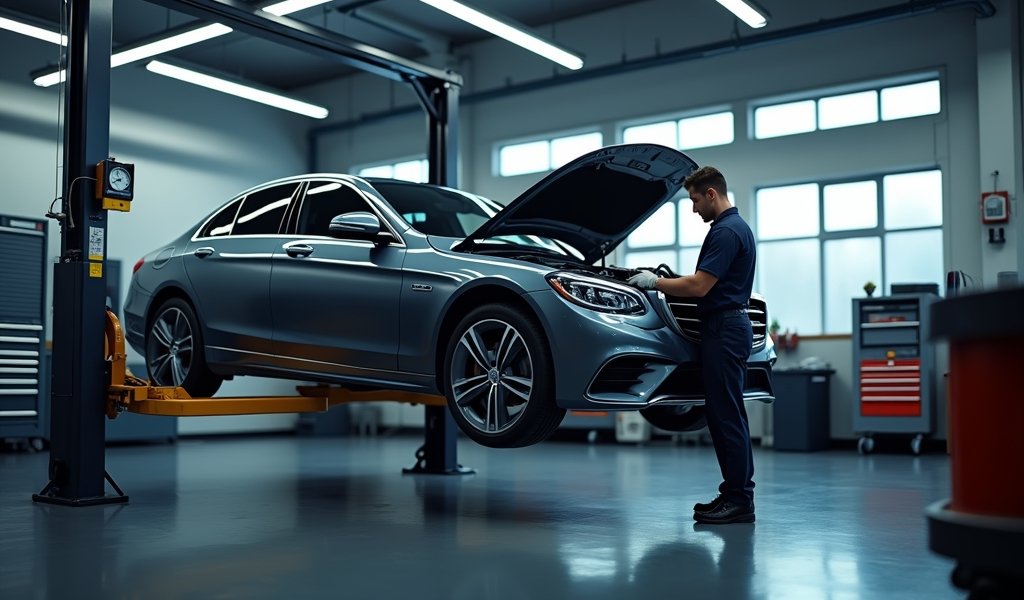Overview
This article provides seven expert tips for maintaining and troubleshooting car air conditioning systems, covering warning signs, maintenance schedules, refrigerant issues, finding qualified technicians, DIY vs. professional repairs, extending system lifespan, and understanding repair costs. The author, a 15-year certified auto cooling specialist, emphasizes that preventative maintenance is far more economical than emergency repairs, and that most AC problems give early warning signs that should not be ignored.
Table of Contents
- Know the Warning Signs of AC Problems
- Regular Maintenance Schedules Save Money
- Understanding Refrigerant Issues
- Finding a Qualified AC Repair Specialist
- DIY vs. Professional Repairs
- Extending Your AC System’s Lifespan
- Understanding Cost Factors in AC Repairs
- Conclusion
- Frequently Asked Questions
When summer temperatures soar, there’s nothing worse than turning on your car’s AC only to feel a blast of hot air. I’ve seen countless drivers roll into our shop with sweat-soaked shirts and frustrated expressions after their cooling systems failed during a heatwave. Your vehicle’s air conditioning isn’t just about comfort—it’s essential for safe driving when temperatures climb.
After 15 years as a certified auto cooling specialist, I’ve diagnosed every car AC issue imaginable. The good news? Many problems can be prevented with proper knowledge and maintenance. In this guide, I’ll share seven proven tips that will keep your car’s AC blowing cold all summer long and help you avoid those emergency car repair visits when you need cooling most.
1. Know the Warning Signs of AC Problems
Your car’s AC system communicates problems before completely failing. Learning these signals can save you hundreds in repair costs. When customers come to our shop, I always ask when they first noticed changes in their cooling system.
Watch for these common warning signs:
- Weak airflow, even at maximum fan settings
- Strange noises when the AC runs (clicking, rattling, or grinding)
- Musty or moldy odors from your vents
- Air that starts cool but quickly turns warm
- Visible leaks or excessive moisture under the dashboard or vehicle
The cooling capacity test is something you can do yourself. On a warm day, set your AC to max cool and recirculation mode. After five minutes, the air from your center vents should measure between 35-45°F. If it’s above 50°F, your system needs attention, according to Department of Energy guidelines.
Don’t ignore intermittent cooling. This often indicates a cycling clutch issue or low refrigerant levels—both relatively minor if caught early, but potentially devastating to your compressor if ignored.
2. Regular Maintenance Schedules Save Money

The most expensive AC repairs I perform are almost always on vehicles that haven’t seen preventative maintenance in years. Think of your car’s AC like dental care—regular checkups prevent painful and costly emergencies.
Here’s the maintenance schedule I recommend to keep your car cool and your wallet happy:
- Every spring: Run a cooling system performance test
- Every 12 months: Replace the cabin air filter
- Every 2 years: Have a professional inspect hoses, belts, and check for refrigerant leaks
- Every 50,000 miles: Consider a full system service including evacuation and recharge
A basic AC inspection costs between $80-150 at most shops. Compare that to a compressor replacement which typically runs $800-1,200 with parts and labor. The math clearly favors prevention. Our records show that vehicles receiving annual AC service last on average 3-5 years longer before needing major repairs.
If you’re seeking affordable auto service, always ask about AC inspection packages in spring. Many shops offer discounted cooling system checks before summer hits.
3. Understanding Refrigerant Issues
Refrigerant problems account for roughly 75% of the AC repairs we perform. This critical fluid absorbs heat inside your vehicle and releases it outside, creating the cooling effect you feel.
Unlike engine oil, refrigerant doesn’t get “used up” during normal operation. If your system is low, you have a leak. Period. When a customer tells me they need their AC “recharged” every summer, I immediately look for leaks in these common locations:
- Condenser (front of radiator) damaged by road debris
- Shrader valves and service port caps
- O-ring seals and hose connections
- Evaporator core (under the dashboard)
- Compressor shaft seal
Modern vehicles use either R-134a or the newer R-1234yf refrigerant. The type matters—using the wrong one can destroy your system and void warranties. This is why refrigerant work requires specialized equipment and EPA certification.
Be suspicious of quick “recharge” services without leak detection. A proper diagnosis includes using UV dye or electronic leak detectors to find the exact source. I’ve seen too many customers waste money on repeated recharges when a $20 O-ring was the culprit all along.
4. Finding a Qualified AC Repair Specialist
Not all mechanics are created equal when it comes to AC work. Cooling systems have become increasingly complex, especially in hybrid and electric vehicles where thermal management is critical.
When seeking a certified car mechanic near me, look for these qualifications:
- ASE certification specifically in Heating & Air Conditioning (A7)
- EPA Section 609 certification for refrigerant handling
- Modern diagnostic equipment including digital manifold gauges
- Experience with your specific vehicle make
Ask these revealing questions before booking service:
- “What diagnostic process do you use for intermittent cooling issues?”
- “How do you verify the system is properly sealed after repairs?”
- “What type of warranty do you offer on AC work?”
Red flags include shops that quote repairs without testing, pressure you into complete system replacement, or offer suspiciously cheap recharge services. Quality AC work requires time, expertise and proper equipment—there are no legitimate shortcuts.
The specialist you choose should explain the specific problem, show you the faulty components when possible, and provide options at different price points. This transparency builds trust and ensures you’re getting exactly what your vehicle needs.
5. DIY vs. Professional Repairs

As someone who worked on cars before becoming a professional mechanic, I understand the satisfaction of DIY repairs. However, AC systems present unique challenges and risks that deserve careful consideration.
What you can safely handle yourself:
- Cabin air filter replacement (typically behind glove compartment)
- Cleaning debris from the condenser fins using compressed air
- Basic performance testing with a digital thermometer
- Checking drive belts for wear or proper tension
What requires professional expertise:
- Any refrigerant handling (EPA regulations prohibit non-certified release)
- Compressor replacement (requires system evacuation and precise oil balance)
- Leak detection and repair
- Electrical diagnosis of climate control systems
Those DIY recharge kits at auto parts stores? They’re problematic for several reasons. Without proper gauges, you can easily overcharge the system, causing compressor damage. They also typically contain leak sealers that can clog critical components and complicate future repairs.
If you enjoy working on your vehicle, focus your DIY efforts on maintenance rather than repair. Regularly cleaning the condenser, checking for visible leaks, and maintaining proper belt tension will help your AC perform optimally between professional services.
6. Extending Your AC System’s Lifespan
The average car AC system should last 8-10 years with proper care. I’ve seen well-maintained systems in 15-year-old vehicles still blowing ice cold. The difference comes down to how you use and maintain your cooling system.
These habits dramatically extend AC lifespan:
- Run your AC for at least 10 minutes weekly, year-round (yes, even in winter)
- Use the defrost mode occasionally, which activates the AC compressor and dries system components
- When entering a hot car, roll down windows for 30 seconds before activating AC
- Use recirculation mode for maximum efficiency once the cabin has initially cooled
- Avoid overloading your system on extremely hot days by setting temperature to 72°F rather than max cool
Many drivers don’t realize that running their AC in winter is essential preventative maintenance. This circulates refrigerant and oil through the compressor seals, preventing them from drying out and leaking. I recommend running the AC for 10 minutes weekly year-round.
Equally important is how you turn on your AC in a hot vehicle. Blasting the system immediately forces it to work hardest when it’s most vulnerable. Instead, roll down windows for 30-60 seconds to release the initial heat, then set the fan to medium before gradually increasing to high.
7. Understanding Cost Factors in AC Repairs
AC repair pricing varies widely based on vehicle make, component accessibility, and the specific issue. Understanding these costs helps you make informed decisions and avoid unnecessary repairs.
Common repair costs (parts and labor):
- Refrigerant leak detection and repair: $150-350
- Compressor replacement: $700-1,200
- Condenser replacement: $450-800
- Evaporator replacement: $800-1,500 (higher due to dashboard removal)
- Expansion valve/orifice tube: $200-400
Many factors affect these prices. European vehicles typically cost 30-50% more than domestic models due to parts pricing and labor complexity. Hybrid and electric vehicles have specialized cooling needs that often increase repair costs.
When to repair vs. replace the entire system? This depends on your vehicle’s age and condition. For cars under 8 years old, component repair is usually the economical choice. For older vehicles with multiple AC issues, a complete system replacement might make sense, especially if you plan to keep the vehicle long-term.
Always get a complete system evaluation before authorizing major repairs. I’ve seen customers replace compressors only to discover their evaporator was also leaking—resulting in double repairs. A proper diagnosis identifies all system issues at once, allowing you to make one informed decision.
Conclusion
Your car’s AC system isn’t just about comfort—it’s about safety and vehicle longevity. By recognizing warning signs early, following proper maintenance schedules, understanding refrigerant issues, finding qualified specialists, knowing what you can DIY, practicing good usage habits, and understanding repair costs, you’ll keep your cool on the road for years to come.
The most important advice I can offer after thousands of AC repairs is simple: don’t wait until your system fails completely. Those small changes in performance—slightly warmer air, reduced airflow, occasional odors—are your system’s way of asking for help before major components fail.
Remember that prevention is always more affordable than emergency repairs. A small investment in regular maintenance saves significantly on major repairs while ensuring you never face that moment of turning your AC to max on a scorching day only to feel warm air.
What AC issues have you experienced in your vehicle? Share your experiences in the comments below, and I’ll be happy to provide specific guidance for your situation.
Frequently Asked Questions
How often should I recharge my car’s AC system?
You shouldn’t need to regularly “recharge” your AC system at all. If your system is low on refrigerant, you have a leak that needs repair before recharging.
Why does my car AC smell musty when I turn it on?
Musty odors typically indicate mold or bacteria growth on your evaporator. This requires an antibacterial evaporator cleaning service, which costs around $100-150.
Can I drive with a broken AC compressor?
Yes, but it depends on how it failed. If the compressor is seized or the pulley is damaged, continuing to drive could cause belt damage or overheat other components.
What causes an AC compressor to fail?
The most common causes are lack of lubrication from low refrigerant, electrical problems, or contamination in the system. Regular maintenance significantly reduces failure risk.
How long does a car AC repair typically take?
Simple repairs like recharging or leak fixes typically take 1-3 hours. Major component replacements like compressors or evaporators can take 4-8 hours depending on vehicle complexity.

